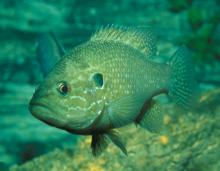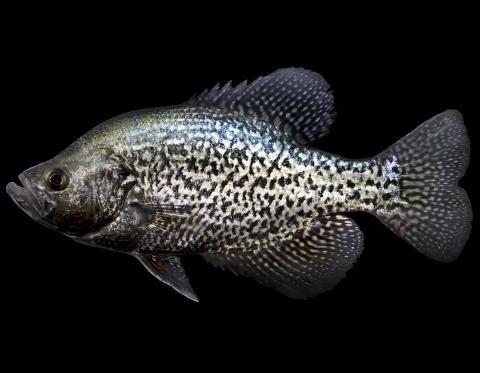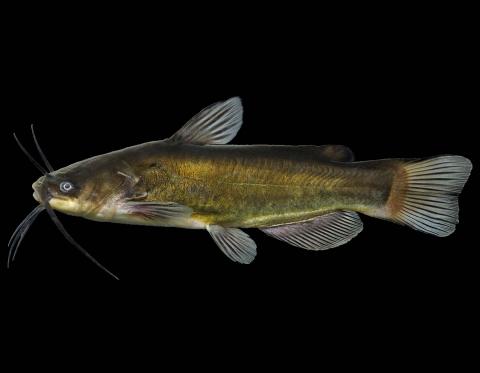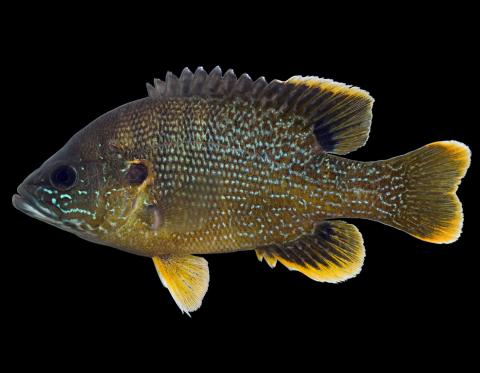Get your new pond off to a good start by stocking the right combination of fish species and sizes in the right sequence. If you don't stock properly in the beginning your pond can develop unbalanced populations of slow-growing, stunted fish.
If you are stocking an older pond you will need to know what fish are already present and their condition. With new or old ponds you must decide whether or not it will support your desired fish population. There are several things to consider.
To prevent fish kills, 5 – 10% of your pond should be at least 8 feet deep.
Shallow ponds are prone to fish kills caused by low oxygen conditions during winter ice over or hot weather drought conditions. To prevent this type of fish kill, your pond should be at least 8 feet deep in 5 percent to 10 percent of the pond area.
Muddy ponds can cause the fish to grow slowly, and the muddiness can be caused by a number of reasons. Your pond needs an adequate watershed to maintain normal water levels and have a structurally sound pond dam and spillway.
Contact your nearest Missouri Department of Conservation office for assistance in diagnosing problems or evaluating your pond for stocking.
Bluegill, channel catfish, largemouth bass are proven stocking combination that provides both food and sport-fishing. When stocked in this order and properly managed, these species provide great fishing and good eating.
Title
Fathead Minnows
Fathead minnows are often stocked in new ponds as a forage fish. Although the bass-bluegill-channel catfish combination will usually do well on its own, minnow stocking helps ensure the fish population gets off to a good start. It will provide bass with a food source as soon as they are large enough to capture it.
Title
Bluegill
Bluegill are well adapted to pond life and particularly suited for stocking in combination with largemouth bass. They serve as a food source for bass, provide fishing opportunities, and taste great. While bass harvest needs to be limited, bluegill are usually more abundant and provide more pounds of fish for harvesting.
Young bluegill eat microscopic plants and animals. As bluegill increase in size, they begin eating aquatic insects, snails, small crayfish, and occasional small fish. Adult bluegill feed mainly on aquatic insects, but will eat terrestrial insects when available.
Most Missouri bluegill weigh under a pound, but they can exceed 12 inches in length. The average life span is about five years, but they can live eight to 10 years. When overabundant, they seldom live more than four to five years and may never exceed 5 inches in length.
Title
Channel Catfish
Channel catfish do well in ponds and provide excellent fishing. Channel catfish eat fish, insects, and aquatic plants. Catfish begin to eat fish when they reach 12 to 14 inches long but are not a significant fish predator in Missouri ponds. They usually eat fish that are generally dead or injured. Small catfish feed on aquatic insect larvae, crayfish and algae.
Fingerling channel catfish stocked in a new pond in the fall can be 11 to 12 inches long the following year, 14 to 15 inches long after two years, and 16 to 18 inches long after three years. Channel catfish may live to be 12 to 15 years old, but six to 10 years is more common.
Channel catfish can and do reproduce in ponds. Spawning usually takes place in a dark cave-like hole. Examples are hollow logs and beaver or muskrat holes enlarged by the male. The fish also use tile and other artificial structures placed in the pond. Spawning in Missouri takes place from late May to late July.
In clear ponds, bass and bluegill usually eat most of the eggs and young. Supplemental stocking is usually needed to maintain the catfish population.
TIP: Because adult bass can eat channel catfish less than 8 inches in length, ponds with an existing bass population should only be stocked with channel catfish that are larger than 8 inches.
For good growth, add up to 20 8-inch or larger catfish per acre per year. Unless you supply additional food, avoid having more than 60 or 70 channel catfish per acre. For best results, keep good records of fish stocked and fish caught and removed.
Channel catfish are available from commercial hatcheries in Missouri. If you only stock channel catfish, reproduction and survival rates can be so high that crowding and slow growth result. This can result in muddy water and fish kills. To keep this from happening, harvest all adults should before they reach 15 inches.
Title
Largemouth Bass
Largemouth bass are well adapted to ponds and reproduce readily in the ponds environment. Bass eat fish and aquatic insects, but also eat frogs and crayfish when available. Less frequently, they will eat mice, moles, snakes, leeches, and baby ducklings. Young bass grow rapidly when food is plentiful.
In ponds with good growth conditions, they may reach a length of 3 to 5 inches their first summer, and from 12 to 15 inches after three years. Largemouth bass, like many other fish, grow faster in the southern part of the state where the growing season is longer, but a lack of soil fertility in some areas may neutralize that advantage.
Largemouth bass usually live 6 to 10 years and can grow larger than 8 pounds. Because the largemouth bass is a predator species and reaches a relatively large size, adequate prey fish must be available for this species to reach its growth potential. Stocked alone, bass usually overpopulate and do not grow well.
Almost any freshwater fish species will live and grow in ponds. Some of these species can add to the enjoyment derived from a pond, and some will help solve or control other problem species. Some of these acceptable species are discussed below.
Redear Sunfish
This sunfish can grow to 12 inches. They reproduce poorly in ponds when competing with bass and bluegill, but generally will maintain a low-density population. They feed on small snails, clams, crayfish and other animals. Redear sunfish may help to control populations of snails, which are a required host in the life cycle of the yellow and black grub. If you want to stock redear in a new or renovated pond, replace 1/4 of the recommended number of bluegill fingerlings with 1- to 2-inch redear in a new pond. When stocking into an established bass population, stock 75 redear that are 4 inches or larger per acre.
Hybrid Sunfish
Hybrid sunfish are an artificial cross between two sunfish species, generally the green sunfish and the bluegill. These hybrids grow larger and more rapidly than regular bluegill, but the difference is slight without artificial feeding. Since they are somewhat more aggressive in their feeding habits, hybrid sunfish are easier to catch than other sunfish. Because they will not typically produce enough offspring to allow bass to grow at normal rates, hybrid sunfish should not be stocked alone with bass. Without artificial feeding, you may stock up to 100 hybrids per acre to replace a similar quantity of bluegill. With feeding, replace up to 200 bluegill per acre with hybrids. If an existing bass population is present, stock hybrids that are at least 4 inches in length at a rate of up to 75 per acre.
Grass Carp
Grass carp are an Asian fish brought to this country because they eat aquatic vegetation. They are commonly stocked to control excess vegetative growth and are available from commercial producers. They will not reproduce in ponds or lakes, but will live up to 10 years and reach weights of 30 to 60 pounds. Average stocking rates to control most rooted vegetation are approximately 2.5 grass carp 8 to 10 inches long per surface acre of vegetation. This species is normally stocked after problem vegetation is apparent.
There are many species that are available to landowners but may cause management problems. These species should be avoided when stocking.
Crappie
Although crappie are valuable sport fish in larger bodies of water, they seldom provide an acceptable harvest in small lakes or ponds. They prey on small fish and compete with adult bass for food. Crappie spawn several weeks earlier than bass and bluegill, so the newly hatched crappie have a head start in the competition for food needed by all later hatched fish. When crappie are stocked in ponds usually one of two conditions develops. A few stocked fish survive predation, live, and grow to a very large size; or, much more commonly, they reproduce and the young survive in great numbers. Soon the pond becomes overpopulated with small, slow-growing crappie that are of an unacceptable size. For these reasons, it is recommended that a Department fisheries biologist be consulted before stocking crappie. Pond owners often stock this species by mistake when they get their fish from creeks or other ponds.
Bullheads
Bullheads, a member of the catfish family, have an almost square tail fin, while the channel catfish’s tail fin is deeply forked. Bullheads, often called mud cats, are not recommended for pond stocking because their bottom feeding activity may cause a pond to become muddy. This handicaps the sight-feeding bass and reduces food production. When stocked alone, bullheads overpopulate. In clear ponds with a good bass population, few bullheads will survive; but the ones that do will grow to a large size, are fun to catch and provide good eating.
Common Carp
Common carp are not recommended for stocking in ponds. These bottom feeders tend to overpopulate and grow slowly. Like bullheads, their feeding activity tends to muddy the water.
Green Sunfish
This species, frequently called pond perch, creek perch or black perch, is often found in ponds that have not yet been stocked with largemouth bass and bluegill. This sunfish is often confused with bluegill. The green sunfish has a much larger mouth and the ear flap is black with a whitish or yellowish margin. Stocking this species in ponds is not recommended. If green sunfish are present before stocking and are large enough to be a predator, they can present a serious threat to the small bass, bluegill and channel catfish that are stocked later.
If green sunfish are allowed to spawn before the bass and bluegill are stocked, severe overpopulation and food competition may occur. The pond may never produce good fishing.
Green sunfish have been used experimentally as a substitute for bluegill in combination with largemouth bass. The green sunfish provided some food for the bass but not enough for good bass growth, and they compete with the bass for many food items. This species is often stocked by pond owners by mistake when they get their fish from creeks or other ponds. Green sunfish will eventually find their way into many ponds. They do not pose a serious problem if the bass population is already present and well managed.
Title
Other Fish Species
While many other species have been stocked in ponds, most have met with limited success. Northern pike, walleye, trout and several species of stream fish have all been tried but usually fail to produce good, sustained fishing without extra management. A common problem with most of these fishes has been their failure to reproduce and maintain the population. If reproduction does occur, there may not be enough food to support desirable populations with adequate growth. Although other sport fish generally are not recommended for small ponds, some species may do well under certain conditions. If you are interested in stocking one of these alternative fish species, contact your local Department office for technical advice.
Title
How To Stock
Many years of study went into determining the recommended stocking rates for Missouri ponds. These rates allow good fish growth and provide enough fish to enable you to keep some without hurting your pond’s future fishing. Good fishing depends on stocking your pond correctly. The Department recommends that the maximum number of largemouth bass, bluegill and channel catfish when stocked in combination be 100 bass, 500 bluegill, and 100 channel catfish fingerlings per surface acre. Stocking at lower densities is recommended in some counties due to a lack of adequate soil fertility. Stocking at higher densities usually results in slow growth and poor fish populations of all species.
Title
Estimating Pond Size
You must know the size of your pond so you can determine the proper numbers of fish to stock. Because most ponds are roughly triangular in shape, a rough estimate of the size can be calculated by stepping off about 2 1/2 feet per step–the length of one shoreline, then stepping off the width of the pond at the dam. Multiply the length and width, divide by the number of square feet in an acre—43,560—and divide by two. This will give a close approximation of the pond size in acres.
Title
When To Stock
Because the chance of a new pond becoming contaminated with undesirable species increases as the pond ages, stocking should occur as soon as possible. If there is any doubt about a pond holding water, stock it for less than the planned original size. Many ponds have failed to produce good fishing because they were stocked at too high a rate. This often happens when a pond has a leak or the owner miscalculates the size when ordering fish. The pond fish population will develop more favorably if it is a few fish short of the recommended stocking rate rather than if stocked with too many fish. The predator/prey balance is very important. It is best to get bluegill established in the fall, and then introduce largemouth bass the following spring. The optional fish recommended should also be established in advance of the bass.
Title
Hauling & Handling
Getting the fish to the pond in good physical condition is essential to produce a healthy population. One way to keep them in good shape is to get them to the pond as quickly as possible. A delay in transport can cause oxygen levels in the water to drop and water temperature to rise, which cause fish to become stressed. Care in handling also is important. Any wound may become infected by bacteria or fungi. Although the fish may go into the pond alive and wiggling, they may later die from these infections. Stressed and wounded fish rarely live long enough to become lunkers. To minimize problems, use water from your pond to fill the containers you use to transport your fish and aerate with a portable pump. If there is a temperature difference of 5 degrees or more between the pond and the water in your hauling container, submerge the hauling container in the pond and slowly exchange water until the temperature of the water in the container is the same as that in the pond. Gradually reducing the temperature difference between the transport water and the pond water will help prevent the fish from dying due to shock.
Title
Sources Of Fish
The development of new ponds, stocked and managed according to recommendations, is a great way to provide more fishing opportunities. Commercial sources of fish are available throughout Missouri. Please contact your nearest Conservation Department office for a list of commercial fish producers, and for more information concerning pond management.
































